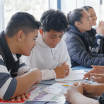Create barrier-free goals and objectives
Suggestion for implementing the strategy ‘How to plan using UDL’
On this page:
On this page:
Current page section: Create barrier-free goals and objectives
Go to top of current page: Create barrier-free goals and objectives
Go to top of current page: Create barrier-free goals and objectives
Go to top of current page: Create barrier-free goals and objectives
Clarify learning intentions
Clarify learning intentions
Define the specific intention of an activity before you start to design.
This will keep your planning focussed on it's purpose.
Check for hidden barriers
Check for hidden barriers
Barriers to achivement can be hidden in the way we communicate goals or learning intentions.
Example of an assignment:
Students will be able to write a report about how ways to increase birdlife at school.
This is two tasks in one: write a report and demonstrate understanding about birdlife in the local area.
When setting goals (intentions):
- identify the purpose and make explicit will be assessed
- check for hidden barriers to achievement
- if possible offer students flexible ways to demonstrate understanding
- if a skill such as “write” is included in the goal, ensure supports such as text-to-speech, graphic organisers, word prediction are offered to all students.
Source: Adapted from Goal-based design and the BC curriculum (opens in a new tab/window)
Share goals in multiple ways
Share goals in multiple ways
Students perceive and make sense of infomation differently.
Present goals in multiple ways to support everyone's understanding.
![11724 [visual-prompts.jpeg]](https://inclusive-live-storagestack-assetstorages3bucket-3uty0hejzw6u.s3.ap-southeast-2.amazonaws.com/public/inclusive-education/example-images/visual-prompts__ScaleMaxWidthWzEwODZd.jpeg)
Source: Ministry of Education | Te Tāhuhu o te Mātauranga
Co-design authentic goals
Co-design authentic goals
![11393 [Fraser-High-School.png]](https://inclusive-live-storagestack-assetstorages3bucket-3uty0hejzw6u.s3.ap-southeast-2.amazonaws.com/public/inclusive-education/example-images/Fraser-High-School__ScaleMaxWidthWzEwODZd.png)
Source: Ministry of Education | Te Tāhuhu o te Mātauranga
Reflection questions
Reflection questions
Consider the following in your own context.
- How can I present learning goals and intentions in varied and flexible ways to support engagement and understanding?
- How can I make sure students don't confuse the purpose of an activty with the means of achieving it?
- Do I offer varied, flexible, and supported pathways to success? Give examples.
Useful resources
Useful resources

Top 10 UDL tips for developing learning goals
A downloadable PDF from CAST with ten tips about learning goals from a UDL perspective
Download PDF

Goals are separate from the means when possible
Barriers to participation and success can be hidden in the way we write or express goals, learning outcomes and success criteria. This step-by-step guide can help teachers design and express barrier-free goals.
Next steps
More suggestions for implementing the strategy “How to plan using UDL”:
-
Current page Create barrier-free goals and objectives
Return to the guide “Universal Design for Learning”

How to use this site
Guide to Index of the guide: Universal Design for Learning
Understand:
- Why UDL is valuable
-
Find out about UDLShow suggestions for Find out about UDL
Strategies for action:
-
Design multiple means of EngagementShow suggestions for Design multiple means of Engagement
-
Design multiple means of RepresentationShow suggestions for Design multiple means of Representation
-
Design multiple means of Action and ExpressionShow suggestions for Design multiple means of Action and Expression
-
How to plan using UDLShow suggestions for How to plan using UDL
- Gather knowledge of learners
- Create barrier-free goals and objectives
- Identify potential barriers
- Consider universal supports and useful options
- Design the experience
- Teach, evaluate, and revise
-
Design considerations in primary settingsShow suggestions for Design considerations in primary settings
-
Design considerations in secondary settingsShow suggestions for Design considerations in secondary settings
-
Design considerations in NCEA assessmentsShow suggestions for Design considerations in NCEA assessments
![11413 [UDL-thinking-what-are-we-here-to-do.jpeg]](https://inclusive-live-storagestack-assetstorages3bucket-3uty0hejzw6u.s3.ap-southeast-2.amazonaws.com/public/inclusive-education/example-images/UDL-thinking-what-are-we-here-to-do__ScaleMaxWidthWzEwODZd.jpeg)
